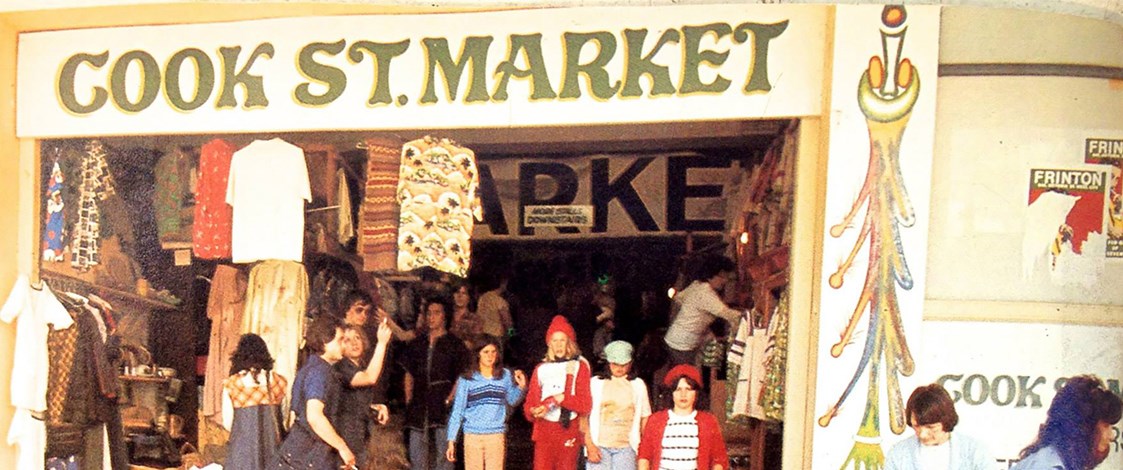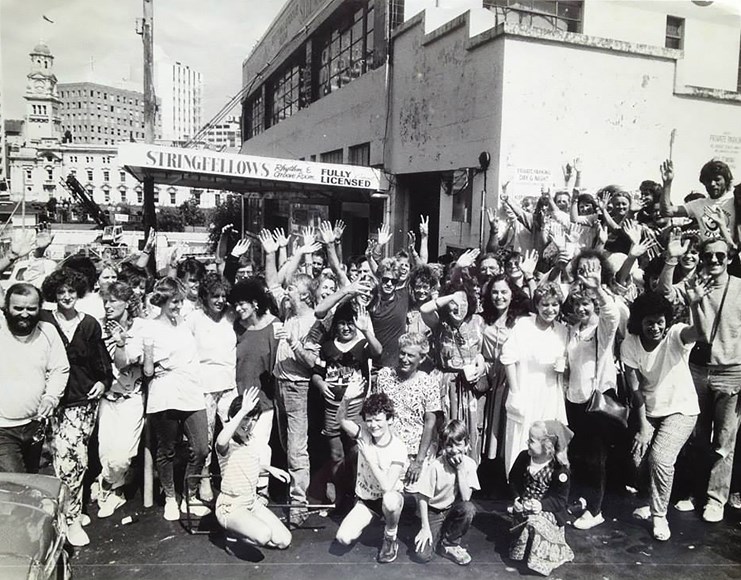Stories
Cook Street Market
1970-1985

When a family of ex-Londoners needed an income to support their families, they decided to open an East End-style market in downtown Auckland. But as well as a livelihood and a new retail destination, Tom Jones and his son and daughter-in-law Brian and Ronnie unintentionally set up a training ground for a generation of New Zealand designers.
Cook Street Market was located in a large building, owned by Auckland City Council, that had previously been home to a carpark and garage. Hoping the market would last at least a few months, Brian and Tom signed a short term rental agreement and opened the doors in 1970.

Brian Jones seated near the market's stage, 1976. Photo by Robin Morrison, © Beverley Price.
Initially, uptake to become a stallholder was slow; the concept of a 'London' market was still new to New Zealand. The market opened every Friday and, as trading laws changed, Saturdays and Sundays as well. Once established, the market grew to become a hub of an alternative culture that attracted massive crowds of shoppers every weekend. At the height of its popularity in the early '80s there were more than 200 stalls; it was almost impossible to rent one, despite the extension of the market into the carpark.

By the early 80s, the market had expanded into the carpark outside. Image © Brandon Jones.
The stallholders became like a family and many children were raised in the market. Brian and Ronnie's son Brandon was nine when the market opened, and he grew up to play an active role. "The market was such an incredible melting pot of humanity and I was able to mix with and befriend people from every walk of life," Brandon recalls. "I had to be able to relate to everyone and often was the 'middle man' between Brian, Ronnie and the stallholders."

Ronnie, Brandon and Brian Jones in "The office" at Cook Street. Image © Brandon Jones.
The majority of the stalls sold clothing of some description, often alongside jewellery, scented love oil (a 70s' essential!) and other intriguing objects. Vintage garments were displayed alongside clothes that both followed and revolutionised mainstream fashion. In the 16 years that the market operated, fashion at Cook Street changed from the crochet shoes and Holly Hobby smock dresses of the '70s, to the Material Girl influence and fingerless lace gloves of the '80s. Cabash, Kelso Khan, Joan of Art, Get Frocked and Leather and Things were just some of the many labels sold at the market.

Hazel Goldwater (pictured) and her sister Karen sold vintage clothes at Cook Street until 1977. Photo by Robin Morrison, © Beverley Price.
Annie McNeur was one stallholder who - in her four stints at the market - adapted her wares as the fashion changed. Annie worked on her friend’s stall selling vintage garments in Cook Street’s first year of operation. Two years later she returned as a stallholder, selling dyed vintage nighties that were worn as dresses, love beads and crocheted garments. After a break she returned to share a stall with a friend, selling herb plants, woven belts, muslin scarves and crochet string bags. She was also wholesaling to the Auckland city retail store, Jennifer Dean. Annie’s final spell lasted until Cook Street closed in December 1985. She employed staff to look after several stalls where she sold a mix of fashion and accessories - lace tops, fingerless lace gloves and hand-dyed calico garments. Aware of the Aotea Square development that could force the market to close, Annie also opened a store, Details, next to Street Life in the Century Arcade.

Annie McNeur and her daughter Emma in the stall she shared with the jeweller, Rique. Image © Annie McNeur.
Sue Bringans and Kim Panther also ventured into retail outside the market, closing their stall after about five years to open their SooKim store on Victoria Street West. Sue was brimming with inspiration and Kim was a skilled pattern cutter able to translate Sue's ideas into finished garments. When she started at Cook Street, Sue did the sewing herself but as the business grew she employed others to help produce enough stock to meet demand. Sue was friends with another stallholder, Denise Campbell, who pioneered 80s knits and rah-rah skirts with mix-and-match sets. Denise went on to open Zainy, a retail store on Ponsonby Road, where she stocked the SooKim label as well as her own 'zainy' knit co-ordinates.

Jacqueline Daley in her stall and Sue Higgins who worked for SooKim. Image © Clear Winchester.
Claire Dutton and Michael Cox were another couple whose stall at Cook Street paved the way to the opening of a retail store. They began selling vintage clothing alongside '50s inspired menswear at Cook Street Market in 1977. Their label, Strangely Normal, came from Claire’s description of Michael’s personality. As the availability of quality vintage clothing grew scarce, they decided to open a retail store in Hobson Street, Auckland in late 1979 where they created and sold their own designs. Strangely Normal is still run by Claire and Michael in O’Connell Street.
MaryJane and Phil O’Reilly arrived at the market in 1974 after travelling around the world making and selling made-to-measure jeans under their label, Black Sheep. "Cook Street gave us a quick way to take our product to market in a city where we knew very few people," recalls MaryJane. "We sold heavyweight 14oz denim jeans, overalls, bags, shirts, jackets and waistcoats, heavily topstitched and with highly detailed styling. They became immensely popular and we usually sold out within 45 minutes of us arriving." The O'Reillys shared a stall with Barbara Allpress and Jim McIntosh who later started their own denim label Roxz with Phil as designer. MaryJane moved on to co-found Limbs Dance Company.

Black Sheep denim garments. All Rights Reserved, Image © MaryJane and Phil O'Reilly.
Janice Giles, whose sister Judy started Expozay, opened a stall at Cook Street in 1976. She designed under the label Le Ballon Rouge, later opening a retail store of the same name. Janice remained in the fashion industry until the late 1980s, designing for Le Ballon Rouge, as well as working with Tony Hart to help establish the Moontide swimwear label.
Raewyn Alexander shared a stall at Cook Street with her friend, Robyn Rastrick, where they sold their own creations, supplemented by second-hand garments and accessories. "I designed things I thought would sell, designs you could not easily get here, based on shapes noted in overseas fashion from magazines like The Face." After travelling overseas, Raewyn secured another stall at the market in 1981. This time she labelled her designs. Describing herself as unaware of the importance of brand, Raewyn kept changing the name of her label, finally settling on Daredevil. This is the label she became known for when, in 1983, she left Cook Street to set up a fashion collective, Zephyr, with a fellow stallholder, Alison Hutton. Alison went on to win the Supreme Award in the 1988 Benson & Hedges Fashion Design Awards.
Law student Susanna Williams didn’t intend to work in fashion but a part-time job at the market convinced her that this was where her future lay. She left university and started selling her designs under the label Susanna Francesca. She loved the immediacy of selling at Cook Street. "You’d make something and within a few days it was in front of a customer base. You would very quickly work out what worked and what didn’t." Susanna continued her involvement in fashion; she worked as a model, opened a retail store, Gillymouse and The Gringo, with another stallholder John Tibbetts and, in 1982, she won the Young Designer category at the Benson & Hedges Fashion Design Awards.
Barbara Holloway and Terry Mason were also Cook Street stallholders whose garments were acknowledged at the Benson & Hedges Fashion Design Awards. Designing silk evening wear with strapless, boned bodices under the label Circe, Barbara and Terry were both finalists in 1984. They bought the silk from Wah Lees in Hobson Street, which alongside the Rendells basement, the navy surplus store and the old warehouses on Darby and Elliott Streets, was one of the unconventional sources of materials used by the Cook Street designers. "Cook Street Market was what Auckland needs today; a collective space, central, with affordable rent and retail exposure to provide opportunities for emerging designers to experiment," Barbara says.

Cook Street Market, circa 1979. All Rights Reserved, Image © Chris Traill.
Despite the protests of the Cook Street Market community, the market closed on 30 November 1985. The building was demolished to make way for the Aotea Theatre complex, and alternative plans that included space for a new venue were rejected by the council. The stallholders dispersed to sell at the smaller markets that were popping up in central Auckland. Many also opened retail stores or headed overseas.

Stallholders in the week before the market closed in November 1985. Photo from the Auckland Star, December 1985. Image © Stuff.
"I didn’t appreciate at the time the market closed just what an enormous hole it was going to leave in so many people’s lives," says Brandon Jones. "It was indeed the sounding board for so many small businesses and young entrepreneurs. Without it, I’m sure it would have been so much harder to find an outlet for all that imaginative energy."

By the 80s, most stallholders who made clothes to sell were designing under a label.
His words would no doubt strike a chord with the many noted designers - among them Kate Sylvester, Ngila Dickson, Adrienne Foote and Chrissy R - whose time spent testing their fashion potential behind a stall at Cook Street Market paved the way for their successful careers.
Text by Kelly Dix. Banner image by Robin Morrison. Image © Beverley Price.
Last published May 2018.